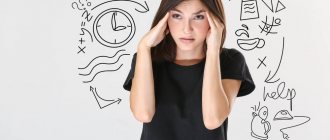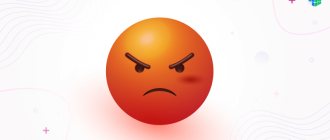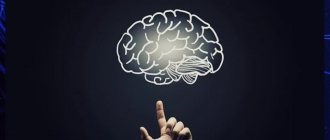Surely most of you have heard the phrase “Conquer yourself and win thousands of battles.” It is this phrase that reflects the whole essence of psychological self-regulation. The ability to control yourself, control your emotions and behavior in various situations is a very important and vital factor for survival in modern society.
Practiced and properly understood self-regulation contributes to prosperity and the fight against stress. To allow yourself to reach this level, you need to be clearly aware of all the types and features of self-control.
What is self-regulation and its types
Therapy specialist Andrea Bell defines self-regulation as the ability to control and restrain oneself from impulsive actions and emotions. The ability to self-regulate helps to resist and thereby control one’s place in society, which indicates the flexibility of a person’s emotional and behavioral state.
In psychology, there are two types of self-regulation:
- emotional - this is the ability to manage your state and emotions. In a moment of depression, lift your mood and the ability to calm down during a period of upset feelings,
— behavioral is the ability to act for the benefit of one’s long-term interests. More precisely, it is the ability to react to various situations, contrary to your feelings.
This is easy to understand using the example of a queue at the checkout. When you are tired, and the cashier is slow and clumsy, and even makes mistakes that lead to proceedings. To his apology and question whether he delayed you too much, you would rather answer, no, with a smile on your face, rather than express everything that you think about him.
For example, correctly developed self-regulation can also include:
- the child stops hysterics when asked to buy him a new toy in return,
- the decision of people to take a break in a sharp discussion in order to prevent a quarrel and not lead the situation to insults,
- choosing low-calorie foods if you want to lose weight.
Such control of emotions helps to achieve certain goals, solve many important problems, and even become a leader in your environment.
It is important to understand that self-regulation includes and makes the following human abilities stronger:
- using self-control to behave with dignity in society and not succumb to weaknesses: alcohol, smoking, using swear words,
- the ability to manage your energy in order to properly distribute the load and achieve desired goals,
- ability to maintain calm and restraint in unpleasant and difficult situations,
- the ability to switch and cope with workload and stress in difficult situations.
It is stress and stressful situations that are decisive factors in self-regulation and the ability to manifest it consciously and unconsciously.
Cybernetic self-regulation of health or how the human body’s defenses work
When I wrote my dissertation many, many years ago, I made the greatest super-duper discovery of the century! People, for the most part, strive to find a source of health outside themselves (i.e., dependence on external things) - vitamins or herbs, nature or medical equipment, more energetic or cheerful interlocutors, purified or mineral water, sweeteners or honey, etc. This is certainly a good thing, but these are not the droids you are looking for! It’s sad for us, rehabilitation specialists, that almost no one cultivates health within themselves. We have especially few tools to protect ourselves from excessive emotional stress, depression and all sorts of viruses with drafts. But for a long time, approximately 100-200 centuries, there have been ways to increase the internal resources of the autonomic and central nervous system to an individual maximum. Upgrade the body, giving the opportunity to perform, that is, psychophysical techniques of self-regulation. They do not promise immortality or clairvoyance, but you can avoid getting sick almost completely (as much as possible) and recover faster from all sorts of disorders. Unless you yourself want to have them again.
UPD: this article is a review, propaganda of self-regulation and scientific and theoretical, not about specific techniques, I did not promise them. If you want them, I can write them in the next article. Or you can contact my fellow doctors, by the way, they are looking for developers and programmers to implement the mobile application “Autotraining in psychosomatics”, here is a Program for teaching relaxation for chronic migraine - PrEVM No. 2019614503
UPD2: at the request of readers, I will later write a review of the best mobile applications that teach the practice of self-regulation, almost replacing a psychotherapist in this.
The most important problem of modern medicine, psychology and even any “non-traditionalism” is reductionism, i.e. one-sided, not comprehensive, insufficiently broad approach to treatment, correction and prevention. Either exclusively physical chemistry, or only increased anxiety or acupuncture points are “panaceally” treated, but in this way each of them can only give a maximum of 33.3% of the total health of the soul and body. And 99-100% help with medicine, nutrition, thinking, communication, movement, and feeling together and at once. This is our (and other integrative specialists') credo. Always.
As you read this article, you will, of course, have doubts that it has little to do with IT, but I ask you to take your time until you have spent some time thinking about or practically applying the described technologies, patents and theories of physiology, medicine and psychology for yourself or work. Let's start in order, as is customary for us, associate professors and students of Academician Anokhin.
Self-regulation is the conscious or unconscious ability of a person and all living beings to manage their neurophysiological state and psychosomatic health, using internal mechanisms, methods of traditional and alternative medicine and psychology due to their knowledge, skills, abilities and innate reflexes. To know means to foresee, and to foresee means to be able or to dominate. However, “it is not the one who lived longer who knows more, but the one who walked further,” so they only “learn from mistakes,” forming new conditioned reflexes (according to Pavlov I.P. and Anokhin P.K.).
The ability of each of us to self-regulate has been confirmed by domestic and foreign scientists who have developed four main theories:
- Homeostasis and homeoresis are the maintenance by the human body itself of the constancy and adaptability of its internal environment (blood, heart, intestines, kidneys, biceps, and so on).
- Stress (adaptation syndrome) is an innate reaction of the individual to external influences, aimed at maintaining social, mental and physical homeostasis.
- Reflexes and functional systems are cybernetic mechanisms of mutual assistance between organs and physiological systems (nervous, endocrine, digestive and others).
- Sanogenesis and immunity are protective reactions of the human and animal body that carry out self-regulation at the cellular and molecular level.
It would seem that it turns out that you don’t need to do anything at all to be healthy, everything happens on its own, you sleep, walk around, eat and you’re fine. But why is it that in reality things are not so rosy with our health? This is due to the fact that man is a social being, and almost nothing allows anything to happen directly, without the participation of consciousness; he wants to understand, control and intervene in the natural order.
However, even if it interferes with your body, it is possible to improve your well-being if you engage in non-medicinal psychophysical self-regulation (health-saving technologies), quickly and effectively, helping your cells comprehensively.
Methods for comprehensively improving the health of mind and body have been around for many centuries. Hippocrates also said that “not only the doctor himself must use everything that is necessary, but also the patient, everyone around him, and all external circumstances must contribute to the doctor in his activities.” There is no point in arguing with the father of Western medicine. In addition, even more ancient Chinese and Indian Ayurvedic medicine based all their diagnostics and treatment on the same holistic (integral and cybernetic) principle. Physical therapy, autogenic training, color therapy, aromatherapy, sound and reflexology, and even taste therapy - all this has long served to heal a person and continues to do so to this day. But, unfortunately, this ancient wealth is not always used by all modern doctors: no one can grasp the immensity.
However, in our time - a time of scientific and technological progress, global chemicalization and electrification, the need for treatment specifically by the human ecological environment as a whole has become much greater than in previous centuries. You can even patent such an “original” method as “ecological therapy” (although there is “nature therapy”). In another way, this technique can be called “multifactorial medicine.” This concept also corresponds to the modern terms “integrative” and “social” medicine. The World Health Organization's biopsychosocial concept of health is also based on a holistic concept of human health.
Another most comprehensive (integrative) approach to psychophysical self-regulation of health can be called such terms as “healthy lifestyle”, “hygiene”, “sanitation”, “human ecology”, Fitwel technologies, wellness and acmeology. It is important that all these sciences emphasize “environmental healing,” that is, the natural and minimally artificial factors surrounding us in everyday life, each of which can be the cause, soil, and method of treatment for emotional or physical disorders.
In order for the cybernetic system of conscious self-regulation to take place, you must first try at least 100 (and not 3-5) different methods, and then choose 2-3 of the most pleasant methods that you can use daily. Basically, these are psychotherapeutic and “naturotherapeutic” techniques. Although you can, of course, use medicinal (any chemistry), physiotherapeutic (artificial fields) and social (anti-toxic networking) approaches to self-regulation.
The most amazing thing is that, even if we are against all this demonic behavior (in religions they don’t really like meditation, yoga and qigong, for example), then our whole life is still endless self-regulation, unconsciously. And moreover, psychological, medical, mental and physical at the same time. But there are also conscious goals of self-regulation, and there is even our official enemy - harmful excessive stress. The so-called pathological emotional stress manifests itself in different ways - it can be constant irritability, unpleasant agitation, chronic fatigue, weakness, negative emotions (anger, resentment, envy), self-deprecation, conflict, aggressiveness, a “bouquet” of chronic diseases (hypertension, ulcers). stomach, diabetes), psychosomatic disorders (headache, constipation, palpitations), feelings of hopelessness, pessimism, inability to control oneself, poor relationships with work colleagues, guilt due to incontinence, fear of the future; this can be listed ad infinitum.
On the other hand, stress is life. Only a living person has the above problems. Only living beings are capable of reacting. Once upon a time, they even wanted to rename the entire science of psychology “reactology.” And that’s why we called the article, for example, not “getting rid of” or “treatment, prevention” of stress or other disorders or diseases, but “self-regulation of health,” that is, cybernetic (according to Anokhin) improvement of one’s psychosomatic well-being. After all, sometimes we are sorely lacking in stressful stimuli and we begin to frantically search for new and/or thrilling sensations. It can be said, therefore, that negative excessive emotional stress is the most common primary cause of disease; at the same time, being positive and dosed, emotional stress turns into a powerful means of treatment.
When the famous scientist Hans Selye proposed the concept of “stress” in 1932, he most likely assumed that this term would become common not only among physiologists and physicians, but also among philosophers. However, he did not think that when this word became international, it would acquire an exclusively negative connotation in society - in colloquial speech and popular literature, the term “stress” would designate only pathological, “bad” stress, which Selye proposed to call by another term, “distress.” .
A state of distress is a pre-neurotic state when signs of neurosis, depression, psychosomatic disorder or even chronic somatic illness are about to appear. In these cases, the help of a qualified specialist is required - a psychotherapist or psychologist. But when distress appears only periodically, then methods of psychophysical self-help, built on universal feedback, including our dearest and most beloved - biological feedback, come in handy.
Thank God that it has long been accepted throughout the world, according to the WHO definition, that “health” is “not only the absence of diseases and physical disabilities, but also a state of complete physical, mental and social well-being.” Therefore, one of the main ideas of this article is precisely that it is necessary to treat or correct not one or another disease or symptom, as is often the case, but “the whole person, like a cybernetic system,” where everything is connected, according to Academician Anokhin and others like them . This idea is completely devoid of historical originality; it will soon be two or three thousand years old, at least. However, for the same amount of time it is not observed by thousands and millions of people and even doctors and psychologists.
After all, no one doubts the fact that each of us has a soul (mental principle), body (biological part) and spirit (social component). Ethics, calmness and posture, for example, are equally necessary for health. And therefore, only a kind and wise chiropractor can really cure a person by adding his own “energy” to his massage - a personal example of a lifestyle for the patient. And another chiropractor is able to reduce lower back pain for just a month or two.
Unfortunately, in Russia and almost all over the world, the training of no doctor includes methods of socio-, psycho-, and biological therapy at the same time; it is not accepted that way. There are, however, separate social workers, psychologists and doctors - all sorts of therapists - excellent specialists, but how rarely do they communicate. Fortunately, things are now changing slightly in two ways. Centers for psychological, medical, and social assistance have been created and are being developed, where specialists from all three areas work together. In addition, the training of today's psychotherapists, psychologists, teachers and social workers began to include introducing them all to each other and joint classes to improve interaction, since there is a need for an integrated approach to a person.
The result of using complex self-regulation techniques is improved health, adjusted at will and in collaboration with specialists and friends. That is, we, specialists in the most comprehensive digitalization of biomedicine and psychology, are interested in increasing the positive, and not fighting the negative, in good health, not only physical, but also emotional and social. We wish you all this from the bottom of our hearts!
What is stress and why is it dangerous?
Stress is an invisible weapon that leads to the destruction of body cells and ultimately manifests itself through various diseases. After a stressful situation occurs, impulses are formed in the human brain that are sent to the cardiovascular, immune and endocrine systems. This is quite enough not only to disrupt self-control and lose vigilance, but also to cause a number of complex diseases. When stress becomes chronic, its effects can be devastating.
The famous neuroendocrinologist McEwen, winner of many prizes and awards, proved:
- prolonged stress has a very bad effect on human memory, which leads to atrophy of neurons,
— acute and prolonged stress suppresses the body’s immune functions, making it weak and defenseless to resistance,
— in the process of stress, the human body produces glucocorticoids, which in the short term have a beneficial effect on it. But as a result of prolonged stress and increased levels of glucocorticoids in the body, it prevents insulin from working in the body, which helps in the absorption of glucose.
It is important to note that stress interferes with:
- control your own fear,
- reduces reproductive functions in the stronger sex,
- damages teeth and gums,
- leads to imbalance throughout the body.








